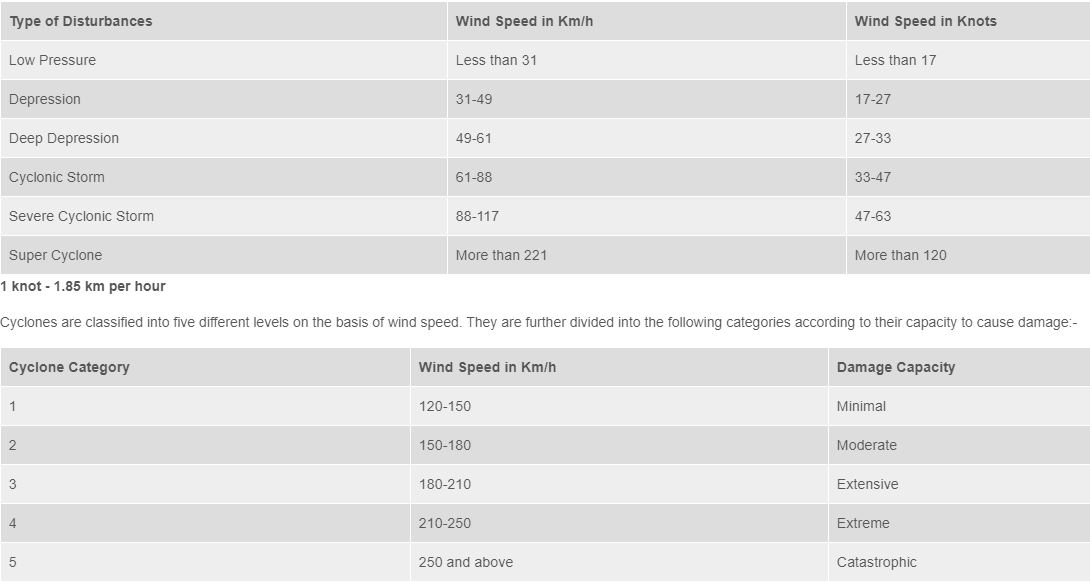Category of cyclonic disturbance
- Cyclones are caused by atmospheric disturbances around a low-pressure area distinguished by swift and often destructive air circulation.
- Cyclones are usually accompanied by violent storms and bad weather.
- The air circulates inward in an anticlockwise direction in the Northern hemisphere and clockwise in the Southern hemisphere.
- Cyclones are classified as:
(i) Extra tropical cyclones (also called temperate cyclones); and
(ii) Tropical cyclones.
- In India, cyclones are classified by:
- Strength of associated winds,
- Storm surges
- Exceptional rainfall occurrences.
- Cyclones are given many names in different regions of the world, They are known as
- Typhoons in the China Sea and Pacific Ocean.
- Hurricanes in the West Indian islands in the Caribbean Sea and Atlantic Ocean.
- Tornados in the Guinea lands of West Africa and southern USA.
- Willy-willies in north-western Australia.
- Tropical cyclones in the Indian Ocean.
- The criteria below have been formulated by the Indian Meteorological Department (IMD), which classifies the low pressure systems in the Bay of Bengal and the Arabian Sea on the basis of capacity to damage, which is adopted by the WMO.

Stages of Cyclone Warning
- The cyclone warnings are issued to state government officials in four stages, they are as follows
- Pre cyclone watch - Issued 72 hours in advance contains early warning about the development of a cyclonic disturbance in the north Indian Ocean, its likely intensification into a tropical cyclone and the coastal belt likely to experience adverse weather.
- This early warning bulletin is issued by the Director General of Meteorology himself and is addressed to the Cabinet Secretary and other senior officers of the Government of India including the Chief Secretaries of concerned maritime states.
- Cyclone Alert (Color code - Yellow) - It is issued at least 48 hrs. in advance of the expected commencement of adverse weather over the coastal areas.
- It contains information on the location and intensity of the storm likely direction of its movement, intensification, coastal districts likely to experience adverse weather and advice to fishermen, general public, media and disaster managers, This is issued by the concerned ACWCs/CWCs and CWD at HQ.
- Cyclone Warning (Color code - Orange) - It is issued at least 24 hours in advance of the expected commencement of adverse weather over the coastal areas.
- Landfall point is forecast at this stage. These warnings are issued by ACWCs/CWCs/and CWD at HQ at 3 hourly interval giving the latest position of cyclone and its intensity, likely point and time of landfall, associated heavy rainfall, strong wind and storm surge along with their impact and advice to general public, media, fishermen and disaster managers.
- Post Landfall Outlook (Color code – Red) It is issued by the concerned ACWCs/CWCs/and CWD at HQ at least 12 hours in advance of expected time of landfall.
- It gives likely direction of movement of the cyclone after its landfall and adverse weather likely to be experienced in the interior areas.
- IMD issues separate live warnings on
- Rainfall
- Wind warning
- Sea conditions
- Fishermen Warning
Buddhist Rock Carvings of Gilgit-Baltistan
- Buddhist rock carvings belonging to 800 AD have been vandalized in the so-called Gilgit-Baltistan area of Pakistan-occupied Kashmir (PoK).
- Buddhist heritage of Gilgit-Baltistan found in the rock carvings and engravings especially in areas like Hunza which were part of the Buddhist circle covering Ladakh and Tibet.
- The engravings have been in news recently also because of the Diamar-Bhasha hydro power project that the Chinese and the Pakistani companies will construct nearby.
- It is a matter of grave concern that Buddhist symbols are being destroyed and the religious and cultural rights and freedoms are being trampled with impunity in the Indian territories under illegal occupation of Pakistan.
- India condemns the defacement and destruction of Indian Buddhist heritage and seeks access to restore the site of archaeological importance.
- Following India’s condemn the rock carvings has been restored recently.
Before After


Ordinance to promote Agriculture
- Recently, the Cabinet has approved a proposal to promulgate three separate ordinances to push agriculture marketing and commodities trade reforms in the country.
- The amendments include the following Acts
- Essential Commodities Act (1955)
- Farming Produce Trade and Commerce (Promotion and Facilitation) Ordinance, 2020.
- Farmers (Empowerment and Protection) Agreement on Price Assurance and Farm Services Ordinance, 2020
- These ordinances are expected to build necessary agrarian infrastructure in the country which are expected to resolve a number of issues of the agricultural sector.
- It is considered as a visionary step towards transformation of agriculture and raising farmers’ income.
Amendments to Essential Commodities Act (1955)
- The imposition of the curbs on stocking of farm produce and regulation of the prices of commodities, etc. under Essential Commodities Act (ECA) are some of factors responsible for less entrepreneurial spirit and thus less investment in the farm sector.
- Under recent amendment any limits under ECA over these commodities will be imposed only in exceptional circumstances such as war, famine, extraordinary price rise and natural calamity.
- The freedom to produce, hold, move, distribute and supply will lead to harnessing economies of scale and attract private sector/foreign direct investment into the agriculture sector.
- It will help drive up investment in cold storages and modernization of the food supply chain.
- The amendment would deregulate the commodities such as cereals, edible oils, oilseeds, pulses, onions and potatoes.
- It will help to lessen the fears of private investors of excessive regulatory interference in their business operations.
- The announced amendment is expected to help both farmers and consumers while bringing in price stability.
- It will also create a competitive market environment and also prevent wastage of Agri-produce that happens due to lack of storage facilities.
Farming Produce Trade and Commerce (Promotion and Facilitation) Ordinance, 2020
- Currently, there are restrictions for farmers in selling agri-produce outside the notified Agricultural Produce Market Committee (APMC).
- The farmers are also restricted to sell the produce only to registered licensees of the State Governments.
- Further, barriers exist in free flow of agriculture produce between various States owing to the prevalence of various APMC legislations enacted by the State Governments.
- The recent ordinance will create an ecosystem where the farmers and traders would enjoy freedom of choice of sale and purchase of agri-produce.
- It will also promote barrier-free inter-state and intra-state trade and commerce outside the physical premises of markets notified under State agricultural produce marketing legislations.
- The ordinance also proposes an electronic trading in transaction platform for ensuring a seamless trade electronically.
- It also proposes to set up a separate dispute resolution mechanism for the farmers.
- It will supplement the existing Minimum Support Price (MSP) procurement system and both will help to provide stable income to farmers.
Farmers (Empowerment and Protection) Agreement on Price Assurance and Farm Services Ordinance, 2020
- Indian Agriculture is characterized by fragmentation due to small holding sizes and has certain weaknesses such as weather dependence, production uncertainties and market unpredictability.
- It makes agriculture risky and inefficient in respect of both input & output management.
- It ordinance will empowers farmers for engaging with processors, wholesalers, aggregators, wholesalers, large retailers, exporters etc. and thus eliminating intermediaries resulting in full realization of price.
- Farmers have been provided adequate protection. Sale, lease or mortgage of farmers’ land is totally prohibited and farmers’ land is also protected against any recovery.
- It also provides an effective dispute resolution mechanism for with clear timelines for redressal
- It contains mechanisms which would transfer the risk of market unpredictability from the farmer to the sponsor.
- It also enables the farmer to access modern technology and better inputs.
- It will reduce the cost of marketing and improve income of farmers
- It will help to attract private sector investment for building supply chains for supply of Indian farm produce to global markets. .
Pharmacopoeia Commission for Indian Medicine and Homoeopathy (PCIM&H)
- Recently, the Union Cabinet has given its approval to re-establish Pharmacopoeia Commission for Indian Medicine and Homoeopathy (PCIM&H) as a subordinate office under the Ministry of AYUSH.
- Pharmacopoeia Laboratory for Indian Medicine (PLIM) and Homoeopathic Pharmacopoeia Laboratory (HPL), central laboratories established at Ghaziabad (Uttar Pradesh) since 1975, will be merged into the PCIM&H.
- Presently, PCIM&H is an autonomous body under the aegis of Ministry of AYUSH, established since 2010.
- Pharmacopoeia is an officially recognized book of standards as per the Drugs and Cosmetics Act, 1940 and Rules 1945 thereunder.
- As per the Second Schedule of the Drugs and Cosmetics Act, it is designated as the official book of standards for drugs imported and/or manufactured for sale, stock or exhibition for sale or distribution in India.
- It specifies the standards of drugs manufactured and marketed in India in terms of their identity, purity and strength.
- The merger intends to accord legal status to the merged structure of PCIM&H and its laboratory by making the necessary amendments and enabling provisions in the Drugs and Cosmetics Rules, 1945.
- Consultations have been done with the Director General Health Services, Drugs Controller General and the Ayurveda, Siddha and Unani Drugs Technical Advisory Board (ASUDTAB).
Ayurveda, Siddha and Unani Drugs Technical Advisory Board
- ASUDTAB is a statutory body under the provisions of Drugs and Cosmetics Act, 1940.
- It advises the central and state governments in regulatory matters of Accelerated Shelf Life Testing (ASLT) drugs.
Accelerated Shelf Life Testing
- It is an indirect method of measuring and estimating the stability of a product by storing the product under controlled conditions that increase the rate of degradation occurring in the product under normal storage conditions.
- ASLT is useful for a number of purposes like:
- To predict product stability including color.
- To determine product safety under abuse conditions.
- To troubleshoot in the initial stages of product development.
- To assess the packaging performance of a product.
Empowered Group of Secretaries (EGoS)
- The Union Cabinet has approved setting up of an empowered group of secretaries (EGoS) and project development cells (PDCs) in Ministries and departments for attracting investments to India.
- Industries are thinking to diversify their investments in different localities, so to ensure that investment is enhanced in India, an EGoS has been formed.
- The PDCs would be responsible for coming up with projects with all approvals and identifying issues with regard to attracting investment that would be brought to the attention of the EGoS.
- The EGoS would be chaired by the Cabinet Secretary and would include as members
- Secretary of the Department for Promotion of Industry and Internal Trade as member convener.
- the NITI Aayog CEO,
- the Commerce Secretary,
- the Revenue Secretary
- Economic Affairs Secretary as members.
- The Secretary of the Department concerned would be co-opted, depending on the project.
Syama Prasad Mookerjee Port
- The Kolkata Port is the oldest operating port in India, and was constructed by the British East India Company.
- It is the only riverine Major Port. Its navigational channel is one of the longest in the world.
- It is the guiding factor to trade and commerce of vast hinterland comprising the entire Eastern India including Bihar and Eastern Uttar Pradesh and the two land-locked Himalayan Kingdoms of Nepal and Bhutan.
- The Kolkata Port Trust is an autonomous body under the Ministry of Shipping, administered through the Major Port Trusts Act, 1963.
- Union Cabinet has given its approval to rename Kolkata Port as Syama Prasad Mookerjee Port.
- Earlier, the announcement was made on the 150th anniversary celebration of the trust.
Shyama Prasad Mookerjee
- He was the founder of Bharatiya Jana Sangh (The Bharatiya Janata Party -BJP is the successor of BJS), born in a Bengali Family in 1901 and lived till 1953.
- He was a leader of Hindu Mahasabha and he served as a minister in the Bengal government in 1937, member of Constituent Assembly and later, the first Lok Sabha.
- He also served as a minister in Nehru’s first cabinet after independence, resigned in 1950 due to differences over relations with Pakistan.
Source: PIB, the Hindu, Indian Express

